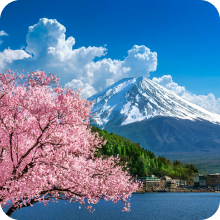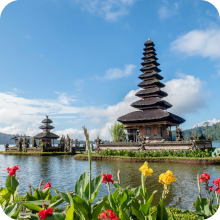Exploring Japan's Rural Villages: A Journey Through History
When most people think of Japan, images of neon-lit streets, bustling cities, and futuristic technology often come to mind. But beyond the urban sprawl lies a different side of Japan—a side where time seems to stand still, where traditions are preserved, and where the beauty of nature and simplicity of life take center stage. Welcome to Japan's rural villages, where history, culture, and breathtaking landscapes converge. Let’s embark on a journey to explore some of the most charming and historically rich rural villages Japan has to offer.
Table of Contents
Shirakawa-go: A UNESCO World Heritage Village
Gassho-Zukuri Farmhouses
Shirakawa-go, nestled in the remote mountains of Gifu Prefecture, is a village straight out of a storybook. Famous for its Gassho-zukuri farmhouses, which resemble hands clasped in prayer, this village is a UNESCO World Heritage site for good reason. The steeply pitched thatched roofs are designed to withstand heavy snowfall, and these centuries-old homes offer a glimpse into a lifestyle that has endured for generations.
Seasonal Beauty
Shirakawa-go is a village that offers a different kind of beauty in every season. In winter, the snow-covered thatched roofs create a magical, almost surreal landscape. Spring brings cherry blossoms and vibrant greenery, while summer offers lush fields and rivers brimming with life. Autumn, with its fiery foliage, adds yet another layer of charm. No matter when you visit, Shirakawa-go will leave you enchanted.
Cultural Experiences
While in Shirakawa-go, take the opportunity to engage with local culture. Many of the farmhouses are open to the public, allowing you to see how traditional Japanese homes were structured. You can also participate in local crafts, such as weaving and dyeing, or time your visit to coincide with one of the village's festivals, where you can experience traditional music, dance, and food.
Tsumago and Magome: Stepping Back in Time
Nakasendo Trail
If you’re looking to step back in time, the historic post towns of Tsumago and Magome in the Kiso Valley are the perfect destinations. Located along the ancient Nakasendo Trail, which once connected Kyoto to Edo (modern-day Tokyo), these towns have been beautifully preserved to maintain their Edo-period charm. A walk along the cobblestone streets of Tsumago and Magome is like traveling back to the days of the samurai.
Preserved Edo-Period Architecture
Both Tsumago and Magome have strict preservation laws that keep modern buildings and conveniences out of sight, allowing visitors to experience the towns as they were centuries ago. The wooden buildings, traditional inns, and stone paths all contribute to an atmosphere that is distinctly old-world Japan. Many of the inns offer traditional Japanese hospitality, with tatami rooms, futon bedding, and home-cooked meals.
Local Delicacies
No visit to Tsumago and Magome would be complete without sampling some local delicacies. Try gohei mochi, a skewered rice cake brushed with a sweet and savory miso sauce, or enjoy a meal of soba noodles made from locally grown buckwheat. These simple yet delicious foods are a testament to the region's rich culinary heritage.
Ouchi-juku: A Post Town Frozen in Time
Samurai-Era Charm
Ouchi-juku, located in Fukushima Prefecture, is another post town that has retained its historical charm. During the Edo period, Ouchi-juku served as a key stop for travelers making their way to and from Aizu. Today, it’s one of the best-preserved examples of a traditional post town, with its main street lined with thatched-roof houses that transport you straight back to the samurai era.
Thatched Roof Houses
The thatched roof houses of Ouchi-juku are a sight to behold. These traditional structures have been meticulously maintained, and many now serve as inns, restaurants, and shops selling local crafts. The town’s layout remains largely unchanged from its days as a bustling post town, offering a rare glimpse into Japan's past.
Notable Landmarks
While in Ouchi-juku, be sure to visit the Tonohetsuri Cliff, a natural rock formation that has been eroded over time into unique shapes. Another must-see is the Ouchi-juku School, a historical building that has been converted into a museum. And don’t miss the opportunity to walk the old highways, where you can imagine the clatter of wooden sandals and the creak of palanquins as travelers once made their way through the town.
Ine no Funaya: The Fishing Village on the Water
Boat Houses (Funaya)
Located on the scenic Tango Peninsula in Kyoto Prefecture, Ine no Funaya is a unique fishing village where the houses are built directly on the water's edge. Known as Funaya, these traditional boat houses have a garage for boats on the first floor and living quarters above. The village, with its serene waterfront setting, offers a glimpse into the traditional maritime lifestyle that has been preserved for generations.
Sea to Table
One of the highlights of visiting Ine no Funaya is enjoying fresh seafood straight from the sea. Local restaurants and inns serve up dishes made from the day's catch, including sushi, sashimi, and grilled fish. This is as fresh as seafood gets, and the taste is nothing short of extraordinary.
Exploring by Boat
To fully appreciate the beauty of Ine no Funaya, take a boat tour around the bay. The view of the boat houses from the water, with the mountains rising in the background, is breathtaking. These tours often include opportunities to feed the fish or even try your hand at fishing, making for a memorable experience in one of Japan's most picturesque villages.
Thanks for visiting our blog, are you planing to travel to Japan? Check out our eSIM Japan.

Takayama: A Town Rich in Tradition
Historic Old Town
Takayama, often referred to as “Little Kyoto,” is a town rich in tradition and history. Located in the Hida region of Gifu Prefecture, Takayama’s old town is famous for its beautifully preserved Edo-period streets. Strolling through the narrow lanes lined with wooden merchant houses, sake breweries, and craft shops feels like stepping into another era.
Takayama Matsuri
One of Japan's most beautiful festivals, the Takayama Matsuri, is held twice a year in spring and autumn. The festival features ornate floats, some of which are hundreds of years old, parading through the town. These floats are meticulously crafted and decorated, showcasing the region's rich cultural heritage. Attending the Takayama Matsuri is a fantastic way to experience traditional Japanese culture up close.
Local Crafts and Markets
Takayama is also known for its vibrant morning markets, where local farmers and artisans sell everything from fresh produce to handmade crafts. The Miyagawa Market, set along the river, is particularly popular. Don’t forget to pick up some Sarubobo dolls, a local craft believed to bring good luck, or sample the region’s famous Hida beef, considered one of the best types of wagyu in Japan.
Hida Furukawa: A Hidden Gem
Traditional White-Walled Storehouses
Just a short distance from Takayama lies Hida Furukawa, a quieter but equally charming town. Known for its traditional white-walled storehouses (kura) and carp-filled canals, Hida Furukawa offers a peaceful retreat with a distinctly traditional atmosphere. The town’s beautifully preserved architecture and serene environment make it a perfect destination for those looking to escape the crowds.
Carp-filled Canals
One of the most striking features of Hida Furukawa is its canals, which are home to hundreds of colorful carp. Walking along these canals, with the white-walled kura reflected in the water, is a tranquil experience that captures the essence of rural Japan. The town also hosts an annual spring festival, during which the canals are lit with lanterns, creating a magical atmosphere.
Cultural Immersion
Hida Furukawa offers several opportunities for cultural immersion. You can participate in traditional paper-making workshops, visit local sake breweries, or even try your hand at crafting your own Sarubobo doll. The town’s slower pace and deep connection to tradition provide a perfect setting for a more intimate and meaningful experience of Japanese culture.
Before you take off make sure to check with local government of the travel status.
FAQs
What is the best time of year to visit Japan's rural villages?
Spring and autumn are ideal, with cherry blossoms or vibrant fall foliage enhancing the experience.
Are Japan’s rural villages accessible by public transportation?
Many villages are accessible by train or bus, but renting a car can provide more flexibility.
Can I stay overnight in Japan's rural villages?
Yes, many villages offer traditional inns (ryokan) and farm stays for an immersive experience.
What should I pack when visiting rural Japan?
Comfortable walking shoes, seasonal clothing, and a camera to capture the stunning landscapes.
Are there guided tours available in these rural villages?
Yes, guided tours are available and can offer deeper insights into the history and culture of the villages.















